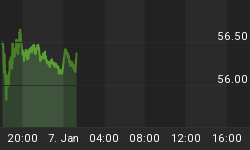Below is an excerpt from a commentary originally posted at www.speculative-investor.com on 12th April 2012.
Considering how popular the term "Quantitative Easing", or "QE" for short, has become, it's remarkable that many commentators on the financial markets appear not to understand what QE is. It is, by definition, an increase in the money supply brought about by the central bank in an effort to reduce the cost of credit. Since the money supply can be increased by commercial banks as well as the central bank, QE can more specifically be defined as an increase in the Monetary Base (bank reserves plus currency in circulation) implemented to reduce the cost of credit. This is because the Monetary Base is the monetary aggregate that the central bank (the Fed in the US) directly controls in its efforts to manipulate the economy.
With the above definition in mind we can easily show that there has been no QE in the US since the completion of "QE2" last June. We simply need to point out that since the end of June-2011 there has been a slight DECLINE in the US Monetary Base -- from $2.64T to $2.63T. Not coincidentally, minimal change in the US Monetary Base since last June has been accompanied by minimal change in the total quantity of Reserve Bank Credit. There have been some shifts between items on the Fed's balance sheet over the period in question. For example, the amount of US Treasury securities held by the Fed increased by $57B and the amount of Mortgage-backed securities held by the Fed decreased by $75B. But the total size of the Fed's balance sheet is almost exactly the same now as it was at the completion of QE2.
Consequently, anyone who claims that the Fed has been engaged in QE over the past 9 months either doesn't understand QE or is more concerned with promoting an agenda than being accurate. There has been a sizable increase in the US money supply over the past 9 months, but this increase is due to the combination of US dollars fleeing Europe's beleaguered banking system and an expansion of US commercial bank credit.
In the US, QE hasn't happened in the recent past and is not happening now. However, it almost certainly will happen in the future. The unfortunate reality is that the most influential people at the Fed believe that increasing the supply of money can help during periods of economic weakness, despite logic and a mountain of historical evidence to the contrary. With a lot of economic weakness lying ahead it is therefore a very good bet that a lot of QE also lies ahead, at least up to the point where "inflation" is widely perceived to be "public enemy no. 1". The only real question concerns timing.
The next round of QE isn't likely to begin until after it becomes obvious to mainstream pundits that US equities have commenced a cyclical bear market and/or that the US economy is headed into recession. This is the sort of cover that the Fed will need, especially with QE2 having clearly failed to do what the publicity machine said it would do.
The November Presidential election could also play a part in the timing of the next round of QE. Bernanke will be reticent to inject himself into the political fray, but that's exactly where he will end up if he appears to be propping up the markets in the lead up to the election without the cover (excuse) described above. In particular, Republican policymakers will be all over Bernanke if he implements pre-election stimulus programs without an 'excuse' in the form of an impending economic emergency.
We aren't offering a free trial subscription at this time, but free samples of our work (excerpts from our regular commentaries) can be viewed at: http://www.speculative-investor.com/new/freesamples.html















